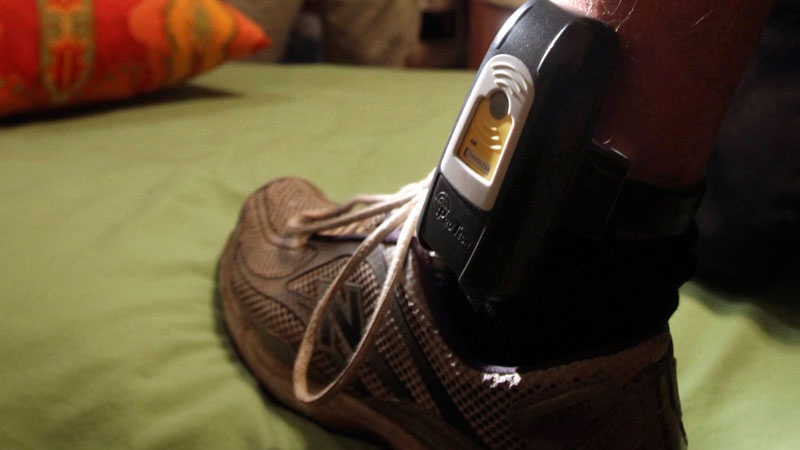Tracking bracelets for offenders implemented in four new Quebec regions
 Parole Agent Steve Nakamura inspects a GPS locater worn on the ankle of a parolee in Rio Linda, Calif. on Aug. 3, 2009. (AP Photo / Rich Pedroncelli)
Parole Agent Steve Nakamura inspects a GPS locater worn on the ankle of a parolee in Rio Linda, Calif. on Aug. 3, 2009. (AP Photo / Rich Pedroncelli)
Tracking bracelets designed to keep individuals accused or convicted of violent acts away from their victims are now being deployed in four new regions of the province: the North Shore, the Eastern Townships, Central Quebec and Montreal.
These regions join those of Quebec City, Chaudière-Appalaches, Joliette and Salaberry-de-Valleyfield, which obtained the device in the spring of 2022. Lanaudière, the Laurentians, Laval and Montérégie implemented the devices last fall. The Mauricie and Outaouais regions were also added to the project in recent weeks.
So far, 65 ankle bracelets have been imposed in the province. A judge, the Quebec Parole Board and the management of a detention facility are authorized to order the wearing of such a device.
The device consists of a non-removable bracelet worn on the ankle by the accused or offender and a mobile application installed on a cell phone given to the victim or alleged victim. As soon as the wearer of the bracelet is within a certain perimeter of the victim's location, a signal is transmitted to a central monitoring station, where a police intervention is triggered.
Quebec is the first province to have equipped itself with the technology that aims to protect victims of domestic violence, Minister of Public Security François Bonnardel said in a news release.
"The bracelet can help save lives and give peace of mind to many women, which is why we are redoubling our efforts since May 2022 to implement it as quickly as possible," the minister said.
According to the deployment schedule of the ankle bracelets, the Bas-Saint-Laurent and the Saguenay-Lac-Saint-Jean should be the next regions to receive the technology in June.
Abitibi-Témiscamingue, Gaspésie-Îles-de-la-Madeleine and Nord-du-Québec will follow in September.
The province-wide deployment of the bracelet comes with an estimated cost of $41 million.
This report by The Canadian Press was first published in French on May 8, 2023. This story was written with the financial assistance of the Meta Grant and The Canadian Press for news.
CTVNews.ca Top Stories

More than 115 cases of eye damage reported in Ontario after solar eclipse
More than 115 people who viewed the solar eclipse in Ontario earlier this month experienced eye damage after the event, according to eye doctors in the province.
B.C. seeks ban on public drug use, dialing back decriminalization
The B.C. NDP has asked the federal government to recriminalize public drug use, marking a major shift in the province's approach to addressing the deadly overdose crisis.
Last letters of pioneering climber who died on Everest reveal dark side of mountaineering
George Mallory is renowned for being one of the first British mountaineers to attempt to scale the dizzying heights of Mount Everest during the 1920s. Nearly a century later, newly digitized letters shed light on Mallory’s hopes and fears about ascending Everest.
Orca calf that was trapped in B.C. lagoon for weeks swims free
An orca whale calf that has been stranded in a B.C. lagoon for weeks after her pregnant mother died swam out on her own early Friday morning.
Sophie Gregoire Trudeau on navigating post-political life, co-parenting and freedom
Sophie Gregoire Trudeau says there is 'still so much love' between her and Prime Minister Justin Trudeau, as they navigate their post-separation relationship co-parenting their three children.
'I was scared': Ontario man's car repossessed after missing two repair loan payments
An Ontario man who took out a loan to pay for auto repairs said his car was repossessed after he missed two payments.
Powerful tornado tears across Nebraska, weather service warns of 'catastrophic' damage
Devastating tornadoes tore across parts of eastern Nebraska and northeast Texas Friday as a multi-day severe thunderstorm event ramped up in the central United States, injuring at least three people.
Toxic testing standoff: Family leaves house over air quality
A Sherwood Park family says their new house is uninhabitable. The McNaughton's say they were forced to leave the house after living there for only a week because contaminants inside made it difficult to breathe.
Trump's lawyers try to discredit testimony of prosecution's first witness in hush money trial
Donald Trump's defence team attacked the credibility Friday of the prosecution's first witness in his hush money case, seeking to discredit testimony detailing a scheme between Trump and a tabloid to bury negative stories to protect the Republican's 2016 presidential campaign.































